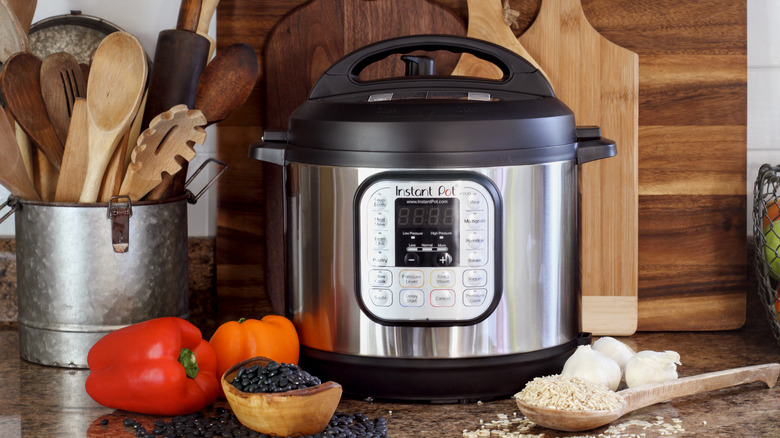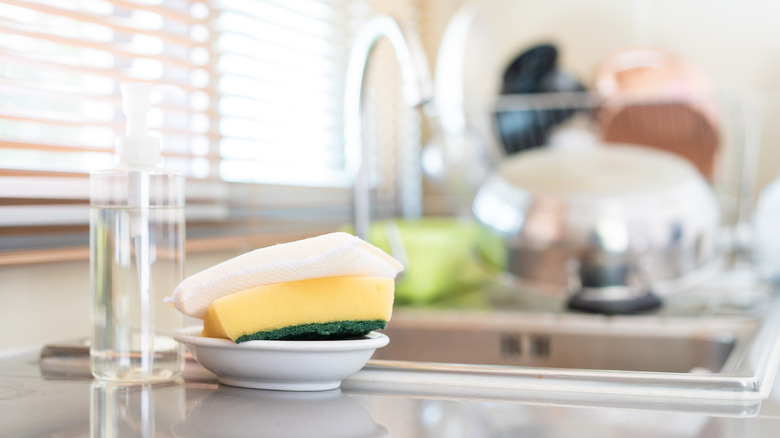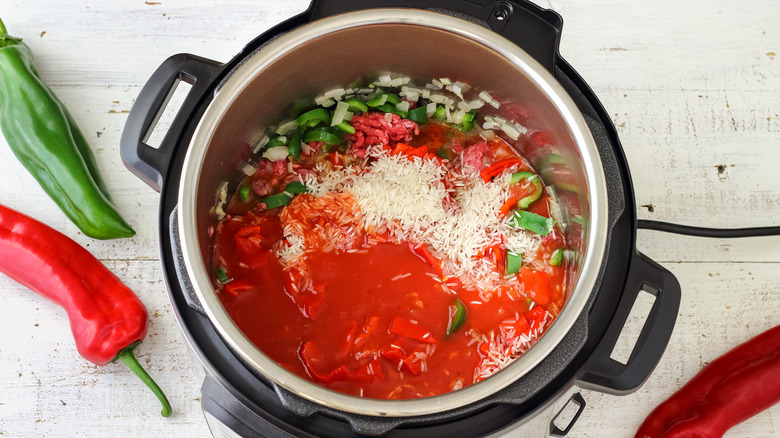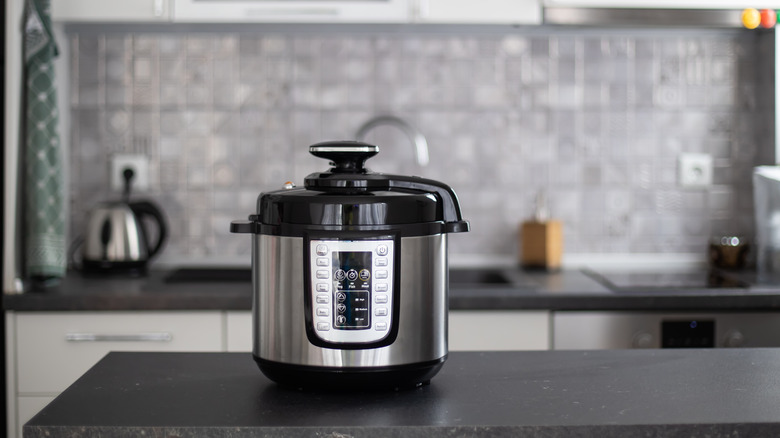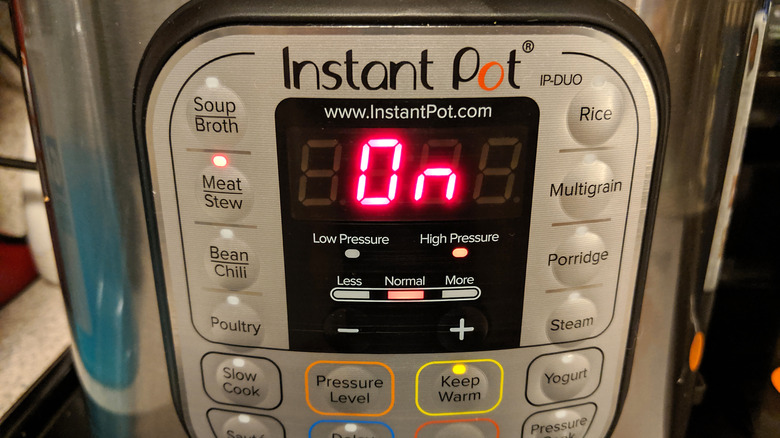How To Clean Your Instant Pot Without Damaging It, According To An Expert
There's a reason that the Instant Pot has remained popular year after year — versatility. First of all, for the time-pressed home cook, the pressure cooker feature means that you can cook things a lot more quickly than in other cooking vessels. However, as many Instant Pot-specific cookbooks and food blogs have highlighted, you can also use the handy kitchen appliance to saute, sear, steam, bake, and even make yogurt.
If you're sold on the usefulness of the Instant Pot, you may still be hesitant to add it to your kitchen arsenal because you're worried about all the effort cleaning it will take. "Cleaning your Instant Pot can seem like a daunting task. You want to make sure you're taking the necessary steps to properly clean it without causing any damage," says Reta Engelking, founder of Cleaning Maid Affordable.
Since there are electronic components built into the appliance, you may be fearful of not only damaging your Instant Pot during your cleaning efforts but potentially even hurting yourself in the process. Luckily, in an exclusive interview with House Digest, Engelking uses her extensive cleaning expertise and experience to walk you through the exact process of properly cleaning your Instant Pot.
Clean the components
One of the easiest ways to accidentally damage your Instant Pot during the cleaning process is by trying to tackle it all at once. However, Engelking advises cleaning the components individually whenever possible. "The first step when cleaning your Instant Pot is to unplug the appliance and remove any inner components. Take out the removable parts (bowls, racks, steam baskets) and separate them accordingly," she recommends. As an added bonus, this approach allows you to clean those components a lot more thoroughly. And, hand-washing the components will ensure you can get into all the nooks and crannies so there's no lingering food residue.
However, Engelking also suggests making things easier for yourself by allowing time to do some of the hard work. "Place these parts in a bowl filled with warm, soapy water and let them soak for about 10-15 minutes before scrubbing away any caked-on residue with a soft sponge or cloth," she suggests. "Rinse them off once they have been cleaned and set aside." Since the appliance is one used to prepare food, you may want to use different cleaning products on the interior components than you would for the exterior. You also never want to use any abrasive cleaning tools that may potentially scratch the appliance.
Tackle the inside of the pot
Depending on what food you cook in an Instant pot, splashes and grease will tend to cover most internal surfaces. "Once all of the components have been removed from your Instant Pot, it's time to give the interior a good cleaning," Engelking explains. Without the components, you'll be able to easily access every square inch of the interior.
"Start by washing down the inside with a damp cloth or sponge lightly soaked in diluted dish soap. Make sure that you are working around all of the nooks and crannies to wipe away any grease or food particles left behind from previous cooking sessions," Engelking suggests. Dish soap is the perfect cleaning solution because it effectively breaks down the grease that you may find on your Instant Pot's interior surface.
And, Engelking also has a tool you may want to try for tricky spots — "if you find that there are stuck-on bits, use a narrow brush or bottle cleaner tool to reach into hard-to-reach areas for thorough cleaning," she advises. Even if you've made something that you don't think necessitates a full cleaning of your Instant Pot, quickly assess the appliance once it's cooled down — it's far easier to wipe away any visible residue when it's relatively fresh rather than having to soak and scrub for stubborn messes.
Tend to the pot's exterior
The exterior of your Instant Pot will likely never get as dirty as the interior. However, you still don't want to skip cleaning that part of your appliance. "Next, move onto wiping down the outside of your Instant Pot to get rid of any spills or splashes that may have occurred during the cooking process. Again, work your way around all edges and crevices with a damp cloth," advises Reta Engelking. Note that a damp cloth is key — you don't want to risk water getting into any of the electrical areas that aren't designed to be submerged.
Engelking recommends taking a few additional steps once you've tended to any spills or splashes on the exterior. "After that's done, take some time to polish up further with stainless steel cleaner (or natural solutions such as baking soda and vinegar) if desired. Finally, using a dry cloth, once more run over every inch of surface area as this will help keep it looking newer longer while also preventing dust build-up over time," she explains. These final steps are particularly important if you have your Instant Pot permanently on your countertop — who wouldn't prefer to see a sparkling appliance ready for its next task? Not to mention, regular cleaning and maintenance will often extend the life of your appliances.
Don't forget to reassemble properly
Before you know it, you'll be cleaning your Instant Pot almost as swiftly as it cooks your food. However, in order to prevent any damage to the appliance, take your time in putting everything back together properly, warns Engelking. "When finished cleaning both sides of your Instant Pot (inside and out), be sure to reassemble all removable parts correctly before plugging it back in again," she recommends. "This will ensure optimal performance for future uses as well as help extend its overall lifespan too.
In fact, some errors in replacing the components could affect your Instant Pot's ability to function altogether. For instance, if your sealing ring isn't put back exactly where it should be, it could compromise the integrity between the lid and the appliance base. Taking a few minutes after cleaning to assess anything that could cause potential issues will prevent future frustrations when you're trying to toss together a quick meal.
